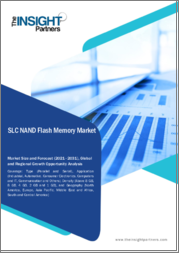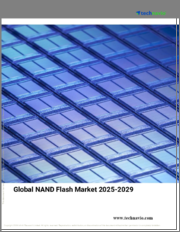
|
시장보고서
상품코드
1625296
세계의 3D 낸드 플래시 메모리 시장 예측(-2030년) : 유형별, 폼 팩터별, 메모리 밀도별, 용도별, 최종 사용자별, 지역별 분석3D Nand Flash Memory Market Forecasts to 2030 - Global Analysis By Type (Single-Level Cell, Multi-Level Cell, Triple-Level Cell and Quad-Level Cell), Form Factor, Memory Density, Application, End User and By Geography |
||||||
Stratistics MRC에 따르면 세계 3D 낸드 플래시 메모리 시장은 2024년에 222억 달러를 차지하고 예측 기간 중 CAGR은 17%를 나타낼 전망이며, 2030년에는 570억 달러에 이를 것으로 예측되고 있습니다.
3D 낸드 플래시 메모리는 메모리 셀의 3D 어레이에 데이터를 저장하는 비휘발성 스토리지 기술이며, 기존 2D NAND에 비해 스토리지 밀도가 높고, 성능이 향상되고 있습니다. 메모리 카드, 스마트폰, 데이터센터 등의 용도에서 널리 사용됩니다. NAND는 기존의 NAND 기술에 비해 데이터 액세스 속도가 빠르고, 소비 전력이 낮고, 내구성이 높습니다.
에릭슨의 모빌리티 보고서에 따르면 북미에서는 2024년 말까지 5G 계약이 모바일 계약의 55%를 차지할 것으로 예상되고 있습니다.
스토리지 용량에 대한 수요 증가
3D 낸드 플래시 메모리는 종래의 2D NAND 기술의 물리적 제약에 대한 해결책을 제공하는 것으로, 실리콘 웨이퍼상의 수평 방향의 공간 제약에 의한 한계가 있습니다. 주어진 영역에서 데이터의 저장 용량을 증가시킵니다. NAND는 제조업체가 더 큰 용량의 스토리지 솔루션을 생산할 수 있는 실행 가능한 솔루션을 제공하며 시장 성장을 가속하고 있습니다.
신뢰성과 내구성에 대한 우려
3D 낸드 플래시 메모리는 프로그램/소거 사이클에서 측정되는 유한 수명을 가지고 있습니다. NAND보다 내구성이 향상되었음에도 불구하고 메모리 셀의 적층이 증가하기 때문에 셀은 시간이 지남에 따라 계속 열화됩니다. 고성능 서버, 데이터센터, 자동차 시스템 등의 용도에 대한 우려 사항입니다. 또한, 조기 마모는 데이터의 파손이나 손실로 이어질 가능성이 있어, 이러한 분야에서의 기술의 매력이 손상되어 시장의 방해가 되고 있습니다.
기존 하드 디스크 드라이브(HDD)에서 SSD(SSD)로의 이동 증가
SSD는 3D NAND 기술을 통해 HDD보다 빠른 읽기/쓰기 속도를 제공합니다. 게임, 영상 제작, AI, 빅데이터 분석 등의 용도에서는 보다 빠른 스토리지가 요구되기 때문에 3D NAND는 고성능 SSD에 매우 중요합니다. SSD에는 가동 부품이 없기 때문에 물리적 손상을 받기 어렵고 내구성도 우수합니다. 점점 더 좋아지고 3D NAND 기반 스토리지 솔루션에 대한 수요가 증가하고 있습니다.
대체 기술과의 경쟁
성능 스토리지 애플리케이션에서 3D NAND의 강력한 경쟁자로 여겨집니다. 아직 도입 초기 단계이지만, 3D XPoint는 속도와 내구성 측면에서 뛰어난 장점을 갖추고 있어 데이터 센터 및 기업 시장에서 강력한 경쟁자로 자리매김할 것입니다. 3D XPoint가 비용 효율성이 더 높고 널리 채택된다면 3D NAND 수요를 감소시킬 수 있습니다.
COVID-19의 영향
COVID-19의 유행은 3D 낸드 플래시 메모리 시장에 큰 영향을 미쳤습니다., 디지털 서비스의 급증은 데이터 스토리지 수요 증가를 촉진하고 시장에 혜택을 가져왔습니다. NAND를 탑재한 SSD의 성장을 뒷받침했습니다.
예측 기간 동안 범용 플래시 스토리지 부문이 최대가 될 것으로 예상
유니버설 플래시 스토리지 부문은 고성능 메모리 솔루션에 대한 수요로 인해 예측 기간 동안 최대 시장 점유율을 보장할 것으로 예상됩니다. NAND와 같은 첨단 낸드 플래시 기술을 사용하여 보다 빠른 읽기/쓰기를 실현하고 있습니다. 유니버설 플래시 스토리지의 성능 기준을 충족하는 3D NAND 수요가 높아지고 있으며, 가전에서 3D NAND 시장이 강화되고 있습니다.
예측기간 동안 데이터센터와 클라우드 서비스 분야의 CAGR이 가장 높아질 전망
데이터센터와 클라우드 서비스는 고속 데이터 검색, 실시간 처리 및 고속 데이터 전송을 위한 3D NAND를 갖춘 SSD와 같은 고급 스토리지 기술로 예측 기간 동안 유리한 성장을 기록할 것으로 예상됩니다. NAND는 HDD와 같은 기존 스토리지 솔루션에 비해 보다 빠른 읽기/쓰기 속도, 낮은 대기 시간, 향상된 내구성을 제공하며 클라우드 스토리지 및 고성능 컴퓨팅 용도에 이상적이기 때문에 3D 낸드 플래시 메모리 시장의 성장을 가속화하고 있습니다.
최대 점유율을 차지하는 지역:
북미, 특히 미국은 스토리지 기술 혁신의 중심지이며, Intel, Micron Technology, Western Digital 등의 대형 반도체 제조업체가 3D 낸드 플래시 메모리 시장 개발을 주도하고 있습니다. 개발과 채용을 가속화, 멀티 레벨 셀(MLC), 트리플 레벨 셀(TLC), 쿼드 레벨 셀(QLC) 3D NAND 메모리와 같은 선구적인 혁신을 통해 세계 시장의 성장을 이끌고 있습니다.
CAGR이 가장 높은 지역:
아시아태평양의 디지털 변혁이 특히 클라우드 컴퓨팅, 빅데이터 분석, AI 기반 용도에서 견고한 데이터 스토리지 솔루션에 대한 수요를 높이고 있기 때문입니다. 신뢰성과 내구성으로 인해 이러한 서비스에 적합합니다. 3D NAND 수요는 APAC 전반에 걸쳐 클라우드 서비스와 데이터센터가 확대됨에 따라 시장 성장을 가속하고 있습니다.
무료 맞춤형 서비스
이 보고서를 구독하는 고객에게는 다음 무료 맞춤설정 옵션 중 하나를 제공합니다.
- 기업 프로파일
- 추가 시장 기업의 종합적 프로파일링(3개사까지)
- 주요 기업의 SWOT 분석(3개사까지)
- 지역 세분화
- 고객의 관심에 응한 주요국 시장 추계·예측·CAGR(주: 타당성 확인에 따름)
- 경쟁 벤치마킹
- 제품 포트폴리오, 지리적 존재, 전략적 제휴에 기반한 주요 기업 벤치마킹
목차
제1장 주요 요약
제2장 서문
- 개요
- 이해관계자
- 조사 범위
- 조사 방법
- 데이터 마이닝
- 데이터 분석
- 데이터 검증
- 조사 접근
- 조사 정보원
- 1차 조사 정보원
- 2차 조사 정보원
- 전제조건
제3장 시장 동향 분석
- 성장 촉진요인
- 억제요인
- 기회
- 위협
- 용도 분석
- 최종 사용자 분석
- 신흥 시장
- COVID-19의 영향
제4장 Porter's Five Forces 분석
- 공급기업의 협상력
- 구매자의 협상력
- 대체품의 위협
- 신규 진입업자의 위협
- 경쟁 기업간 경쟁 관계
제5장 세계의 3D 낸드 플래시 메모리 시장 : 유형별
- 싱글 레벨 셀
- 멀티 레벨 셀
- 트리플 레벨 셀
- 쿼드 레벨 셀
제6장 세계의 3D 낸드 플래시 메모리 시장 : 폼 팩터별
- 유니버설 플래시 스토리지
- 비휘발성 메모리 익스프레스
- 내장 멀티미디어 카드
- SSD
- 기타 폼 팩터
제7장 세계의 3D 낸드 플래시 메모리 시장 : 메모리 밀도별
- 저밀도 메모리
- 고밀도 메모리
제8장 세계의 3D 낸드 플래시 메모리 시장 : 용도별
- 스마트폰과 웨어러블
- 태블릿과 노트북
- 데이터센터와 클라우드 서비스
- 고성능 컴퓨팅
- 스토리지 어레이 및 서버
- 선진 운전 지원 시스템
- 기타 용도
제9장 세계의 3D 낸드 플래시 메모리 시장 : 최종 사용자별
- 가전
- 자동차
- 산업과 IoT
- 엔터프라이즈 스토리지
- 기타 최종 사용자
제10장 세계의 3D 낸드 플래시 메모리 시장 :지역별
- 북미
- 미국
- 캐나다
- 멕시코
- 유럽
- 독일
- 영국
- 이탈리아
- 프랑스
- 스페인
- 기타 유럽
- 아시아태평양
- 일본
- 중국
- 인도
- 호주
- 뉴질랜드
- 한국
- 기타 아시아태평양
- 남미
- 아르헨티나
- 브라질
- 칠레
- 기타 남미
- 중동 및 아프리카
- 사우디아라비아
- 아랍에미리트(UAE)
- 카타르
- 남아프리카
- 기타 중동 및 아프리카
제11장 주요 발전
- 계약, 파트너십, 협업, 합작 투자
- 인수와 합병
- 신제품 발매
- 사업 확대
- 기타 주요 전략
제12장 기업 프로파일링
- Samsung Electronics Co.Ltd.
- Toshiba Corporation
- SK Hynix Semiconductor Inc.
- Micron Technology Inc.
- Intel Corporation
- Apple Inc.
- Lenovo Group Ltd
- Advanced Micro Devices
- STMicroelectronics
- SanDisk Corporation
- Western Digital
- VIA Technologies INC.
- Infineon Technologies AG
- Microchip Technology Inc.
- ON Semiconductor
- Integrated Silicon Solution Inc.
- Realtek Semiconductor Corp.
According to Stratistics MRC, the Global 3D Nand Flash Memory Market is accounted for $22.2 billion in 2024 and is expected to reach $57.0 billion by 2030 growing at a CAGR of 17% during the forecast period. 3D NAND Flash Memory is a non-volatile storage technology that stores data in a 3D array of memory cells, resulting in higher storage density and improved performance compared to traditional 2D NAND. This technology stacks memory cells vertically in multiple layers, increasing storage capacity without requiring more surface area. It is widely used in applications like solid-state drives, memory cards, smartphones, and data centers. 3D NAND offers faster data access speeds, lower power consumption, and higher durability compared to older NAND technologies.
According to the Ericsson Mobility report, in the North American region, 5G subscriptions are expected to account for 55% of mobile subscriptions by the end of 2024.
Market Dynamics:
Driver:
Increasing demand for storage capacity
3D NAND flash memory offers a solution to the physical limitations of traditional 2D NAND technology, which has limitations due to horizontal space constraints on silicon wafers. By stacking memory cells vertically, 3D NAND increases the storage capacity of data in a given area. As demand for high-capacity devices like SSDs, smartphones, and laptops increases, 3D NAND provides a viable solution for manufacturers to produce storage solutions with higher capacities boosting the market growth.
Restraint:
Reliability and durability concerns
3D NAND flash memory has a finite lifespan, measured in Program/Erase cycles. Despite its improved endurance over 2D NAND, the cells continue to degrade over time due to increased stacking of memory cells. This reduced lifespan is a concern for applications like high-performance servers, data centers, and automotive systems, where data reliability and endurance are crucial. Moreover premature wear can lead to data corruption or loss, undermining the technology's appeal in these sectors hampers the market.
Opportunity:
Increasing shift from traditional hard disk drives (HDDs) to solid-state drives (SSDs)
SSDs offer faster read/write speeds compared to HDDs, thanks to 3D NAND technology. This technology reduces latency and stores more data in a smaller area, enhancing data transfer speeds. As applications like gaming, video production, AI, and big data analytics demand faster storage, 3D NAND is crucial for high-performance SSDs. SSDs also offer superior durability due to their lack of moving parts, making them less susceptible to physical damage. As businesses and consumers prioritize reliability, SSDs are increasingly preferred, boosting demand for 3D NAND-based storage solutions.
Threat:
Competition from alternative technologies
3D XPoint, a non-volatile memory technology developed by Intel and Micron, is a potential alternative to 3D NAND, offering higher performance, lower latency, and greater endurance. It is seen as a strong competitor to 3D NAND in high-performance storage applications. Although still in its early stages of adoption, 3D XPoint's advantages in speed and endurance make it a strong competitor in the data center and enterprise markets. If more cost-effective and widely adopted, 3D XPoint could reduce demand for 3D NAND.
Covid-19 Impact
The COVID-19 pandemic significantly impacted the 3D NAND flash memory market. Supply chain disruptions, including semiconductor shortages and factory shutdowns, led to delays in production and increased costs. However, the surge in remote work, e-commerce, and digital services drove higher demand for data storage, benefiting the market. The expansion of cloud computing, gaming, and AI applications also fueled growth in SSDs powered by 3D NAND.
The universal flash storage segment is expected to be the largest during the forecast period
The universal flash storage segment is predicted to secure the largest market share throughout the forecast period owing to demand for high-performance memory solutions. The latest versions, universal flash storage 2.1 and universal flash storage 3.1, use advanced NAND flash technology like 3D NAND for faster read and write speeds. The growing adoption of universal flash storage 3.1 in smartphones, tablets, and laptops is boosting demand for high-speed NAND memory, particularly 3D NAND, which meets universal flash storage performance standards, strengthening the 3D NAND market in consumer electronics.
The data centers & cloud services segment is expected to have the highest CAGR during the forecast period
The data centers & cloud services is expected to register lucrative growth during the estimation period due to advanced storage technologies like solid-state drives powered by 3D NAND for rapid data retrieval, real-time processing, and high-speed data transfer. 3D NAND offers faster read/write speeds, lower latency, and enhanced durability compared to traditional storage solutions like HDDs, making it ideal for cloud storage and high-performance computing applications accelerating the growth of the 3D NAND flash memory market.
Region with largest share:
During the estimation period, the North America region is expected to capture the largest market share owing to North America, particularly the US, is a hub for innovation in storage technologies, with leading semiconductor manufacturers like Intel, Micron Technology, and Western Digital leading the development of 3D NAND flash memory. This leadership in technological innovation accelerates the development and adoption of 3D NAND flash memory, driving global market growth through pioneering innovations like multi-level cell (MLC), triple-level cell (TLC), and quad-level cell (QLC) 3D NAND memory.
Region with highest CAGR:
Over the forecasted timeframe, the Asia Pacific is anticipated to exhibit the highest CAGR due to region's digital transformation is boosting the demand for robust data storage solutions, especially in cloud computing, big data analytics, and AI-based applications. High-performance storage solutions, such as 3D NAND, are well-suited for these services due to their speed, reliability, and endurance. The demand for 3D NAND is increasing due to the expansion of cloud services and data centers across APAC, fostering market growth.
Key players in the market
Some of the key players in 3D Nand Flash Memory market include Samsung Electronics Co.Ltd., Toshiba Corporation, SK Hynix Semiconductor Inc., Micron Technology Inc., Intel Corporation, Apple Inc., Lenovo Group Ltd, Advanced Micro Devices, STMicroelectronics, SanDisk Corporation, Western Digital, VIA Technologies INC, Infineon Technologies AG, Microchip Technology Inc., ON Semiconductor, Integrated Silicon Solution Inc. and Realtek Semiconductor Corp.
Key Developments:
In December 2024, Quobly Forges & STMicroelectronics announced a transformative collaboration with STMicroelectronics, a global semiconductor leader serving customers across the spectrum of electronics applications, to produce quantum processor units (QPUs) at scale.
In November 2024, Nimbus and Toshiba announced joint development of next-generation pure hydrogen fuel cell stack. Under this agreement, Nimbus will combine its patented "four-fluid stack technology" with Toshiba's long-established "fuel cell commercialization and mass production technology" to jointly develop the pure hydrogen fuel cell stack.
In November 2024, Toshiba Electronic Devices & Storage Corporation has launched TLX9152M an automotive photorelay with an output withstand voltage of 900V (min) that is highly suitable for application in high voltage automotive batteries. The new photorelay is housed in an SO16L-T package Volume shipments.
In May 2024, Bosch Ventures Amplifies Commitment to Cleantech with two Battery Recycling Investments. In an electrified world, battery recycling makes a significant contribution to conserving natural resources.
Types Covered:
- Single-Level Cell
- Multi-Level Cell
- Triple-Level Cell
- Quad-Level Cell
Form Factors Covered:
- Universal Flash Storage
- Non-Volatile Memory Express
- embedded MultiMediaCard
- Solid-State Drives
- Other Form Factors
Memory Densities Covered:
- Low-Density Memory
- High-Density Memory
Applications Covered:
- Smartphones & Wearables
- Tablets & Laptops
- Data Centers & Cloud Services
- High-Performance Computing
- Storage Arrays & Servers
- Advanced Driver-Assistance Systems
- Other Applications
End Users Covered:
- Consumer Electronics
- Automotive
- Industrial and IoT
- Enterprise Storage
- Other End User
Regions Covered:
- North America
- US
- Canada
- Mexico
- Europe
- Germany
- UK
- Italy
- France
- Spain
- Rest of Europe
- Asia Pacific
- Japan
- China
- India
- Australia
- New Zealand
- South Korea
- Rest of Asia Pacific
- South America
- Argentina
- Brazil
- Chile
- Rest of South America
- Middle East & Africa
- Saudi Arabia
- UAE
- Qatar
- South Africa
- Rest of Middle East & Africa
What our report offers:
- Market share assessments for the regional and country-level segments
- Strategic recommendations for the new entrants
- Covers Market data for the years 2022, 2023, 2024, 2026, and 2030
- Market Trends (Drivers, Constraints, Opportunities, Threats, Challenges, Investment Opportunities, and recommendations)
- Strategic recommendations in key business segments based on the market estimations
- Competitive landscaping mapping the key common trends
- Company profiling with detailed strategies, financials, and recent developments
- Supply chain trends mapping the latest technological advancements
Free Customization Offerings:
All the customers of this report will be entitled to receive one of the following free customization options:
- Company Profiling
- Comprehensive profiling of additional market players (up to 3)
- SWOT Analysis of key players (up to 3)
- Regional Segmentation
- Market estimations, Forecasts and CAGR of any prominent country as per the client's interest (Note: Depends on feasibility check)
- Competitive Benchmarking
- Benchmarking of key players based on product portfolio, geographical presence, and strategic alliances
Table of Contents
1 Executive Summary
2 Preface
- 2.1 Abstract
- 2.2 Stake Holders
- 2.3 Research Scope
- 2.4 Research Methodology
- 2.4.1 Data Mining
- 2.4.2 Data Analysis
- 2.4.3 Data Validation
- 2.4.4 Research Approach
- 2.5 Research Sources
- 2.5.1 Primary Research Sources
- 2.5.2 Secondary Research Sources
- 2.5.3 Assumptions
3 Market Trend Analysis
- 3.1 Introduction
- 3.2 Drivers
- 3.3 Restraints
- 3.4 Opportunities
- 3.5 Threats
- 3.6 Application Analysis
- 3.7 End User Analysis
- 3.8 Emerging Markets
- 3.9 Impact of Covid-19
4 Porters Five Force Analysis
- 4.1 Bargaining power of suppliers
- 4.2 Bargaining power of buyers
- 4.3 Threat of substitutes
- 4.4 Threat of new entrants
- 4.5 Competitive rivalry
5 Global 3D Nand Flash Memory Market, By Type
- 5.1 Introduction
- 5.2 Single-Level Cell
- 5.3 Multi-Level Cell
- 5.4 Triple-Level Cell
- 5.5 Quad-Level Cell
6 Global 3D Nand Flash Memory Market, By Form Factor
- 6.1 Introduction
- 6.2 Universal Flash Storage
- 6.3 Non-Volatile Memory Express
- 6.4 embedded MultiMediaCard
- 6.5 Solid-State Drives
- 6.6 Other Form Factors
7 Global 3D Nand Flash Memory Market, By Memory Density
- 7.1 Introduction
- 7.2 Low-Density Memory
- 7.3 High-Density Memory
8 Global 3D Nand Flash Memory Market, By Application
- 8.1 Introduction
- 8.2 Smartphones & Wearables
- 8.3 Tablets & Laptops
- 8.4 Data Centers & Cloud Services
- 8.5 High-Performance Computing
- 8.6 Storage Arrays & Servers
- 8.7 Advanced Driver-Assistance Systems
- 8.8 Other Applications
9 Global 3D Nand Flash Memory Market, By End User
- 9.1 Introduction
- 9.2 Consumer Electronics
- 9.3 Automotive
- 9.4 Industrial and IoT
- 9.5 Enterprise Storage
- 9.6 Other End User
10 Global 3D Nand Flash Memory Market, By Geography
- 10.1 Introduction
- 10.2 North America
- 10.2.1 US
- 10.2.2 Canada
- 10.2.3 Mexico
- 10.3 Europe
- 10.3.1 Germany
- 10.3.2 UK
- 10.3.3 Italy
- 10.3.4 France
- 10.3.5 Spain
- 10.3.6 Rest of Europe
- 10.4 Asia Pacific
- 10.4.1 Japan
- 10.4.2 China
- 10.4.3 India
- 10.4.4 Australia
- 10.4.5 New Zealand
- 10.4.6 South Korea
- 10.4.7 Rest of Asia Pacific
- 10.5 South America
- 10.5.1 Argentina
- 10.5.2 Brazil
- 10.5.3 Chile
- 10.5.4 Rest of South America
- 10.6 Middle East & Africa
- 10.6.1 Saudi Arabia
- 10.6.2 UAE
- 10.6.3 Qatar
- 10.6.4 South Africa
- 10.6.5 Rest of Middle East & Africa
11 Key Developments
- 11.1 Agreements, Partnerships, Collaborations and Joint Ventures
- 11.2 Acquisitions & Mergers
- 11.3 New Product Launch
- 11.4 Expansions
- 11.5 Other Key Strategies
12 Company Profiling
- 12.1 Samsung Electronics Co.Ltd.
- 12.2 Toshiba Corporation
- 12.3 SK Hynix Semiconductor Inc.
- 12.4 Micron Technology Inc.
- 12.5 Intel Corporation
- 12.6 Apple Inc.
- 12.7 Lenovo Group Ltd
- 12.8 Advanced Micro Devices
- 12.9 STMicroelectronics
- 12.10 SanDisk Corporation
- 12.11 Western Digital
- 12.12 VIA Technologies INC.
- 12.13 Infineon Technologies AG
- 12.14 Microchip Technology Inc.
- 12.15 ON Semiconductor
- 12.16 Integrated Silicon Solution Inc.
- 12.17 Realtek Semiconductor Corp.



















